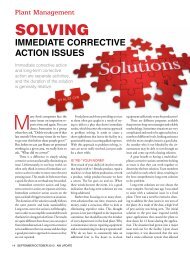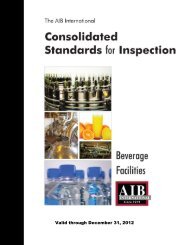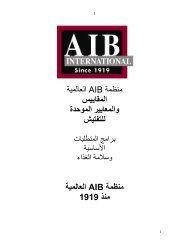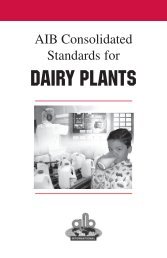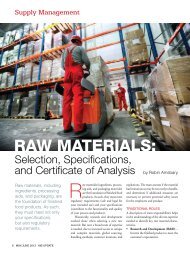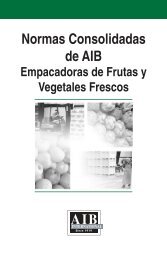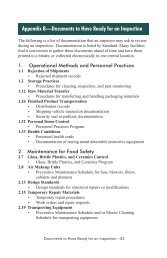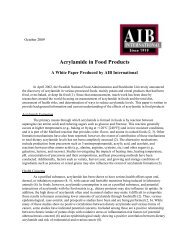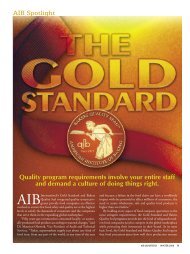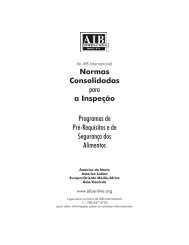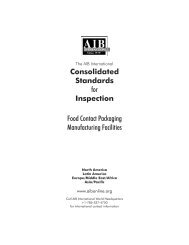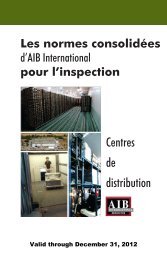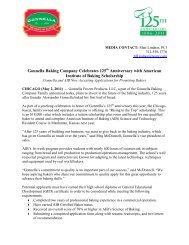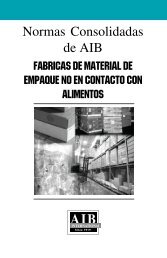Consolidated Standards for Inspection Food Distribution Centers
Consolidated Standards for Inspection Food Distribution Centers
Consolidated Standards for Inspection Food Distribution Centers
You also want an ePaper? Increase the reach of your titles
YUMPU automatically turns print PDFs into web optimized ePapers that Google loves.
2.11.1.2 External doors, windows, or other openings are close-fi tting or otherwise pest-proofed to less than ¼ in. or 6 mm.<br />
2.11.1.3 Windows, doors, and skylights that must be kept open <strong>for</strong> ventilation are screened to prevent pest entry.<br />
2.12 Leaks and Lubrication<br />
Leaks, oil, and lubrication are managed so they do not contaminate food products.<br />
Ө<br />
Critical Requirements<br />
2.12.1.1 The facility prevents, identifi es, and eliminates leaks (oil and lubricants) and excessive lubrication.<br />
2.14 Cross Contamination Prevention<br />
Different steps in the production of food products can negatively impact processing in other areas. Segregation of<br />
operations minimizes opportunities <strong>for</strong> food hazards to arise.<br />
Critical Requirements<br />
2.14.1.1 Operations are separated based on process fl ow, material types, equipment, personnel, airfl ow, air quality,<br />
and services needed.<br />
2.14.1.2 The process fl ow, from receiving to shipping, is arranged to prevent product contamination.<br />
2.14.1.3 Areas <strong>for</strong> washing and cleaning are located away from production activities, where appropriate.<br />
2.14.1.4 Toilet rooms are provided with functional exhaust fans that exhaust to the outdoors or do not open directly<br />
into production, packaging, or raw material storage areas.<br />
Ө 2.14.1.6 Water installations and equipment are constructed and maintained to prevent back siphonage and backfl ow.<br />
2.14.1.7 The sewage disposal system is adequate <strong>for</strong> the process and maintained to prevent direct or indirect product<br />
contamination.<br />
2.15 Equipment and Utensil Construction<br />
Equipment and utensils designed <strong>for</strong> easy maintenance ensure compliance with Prerequisite and <strong>Food</strong> Safety Programs.<br />
Surfaces that deteriorate, or cannot be cleaned or maintained, may present product contamination hazards.<br />
Critical Requirements<br />
2.15.1.1 All equipment and utensils are designed and made of materials that are easily cleaned and maintained.<br />
Ө<br />
2.15.1.3 <strong>Food</strong> contact surfaces are corrosion-free, durable, and made of non-toxic materials.<br />
2.15.1.4 Seams on food contact surfaces are smooth and free of spot or tack welds.<br />
2.16 Temporary Repair Materials<br />
Temporary repairs are sometimes needed or unavoidable. Procedures to ensure that they do not become a contamination<br />
hazard are defi ned.<br />
Critical Requirements<br />
2.16.1.1 Tape, wire, string, cardboard, plastic, and other temporary materials are not used <strong>for</strong> permanent repairs.<br />
If used <strong>for</strong> emergency repairs, they are dated and replaced with a permanent repair as soon as possible.<br />
2.16.1.2 Any temporary repairs on food contact surfaces are constructed of food-grade material.<br />
2.16.1.3 The facility maintains a record of work orders or repair requests.<br />
2.16.1.4 The facility follows temporary repair procedures.<br />
Minor Requirements<br />
2.16.2.1 Temporary repair issues are resolved as soon as possible and practical.<br />
10—<strong>Consolidated</strong> <strong>Standards</strong> <strong>for</strong> <strong>Inspection</strong>



